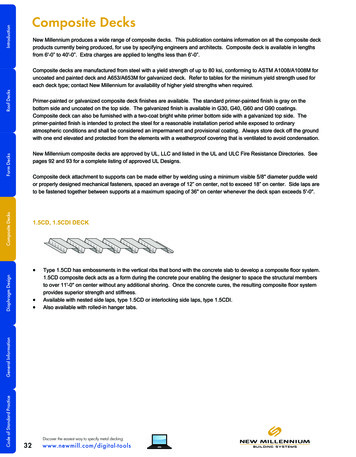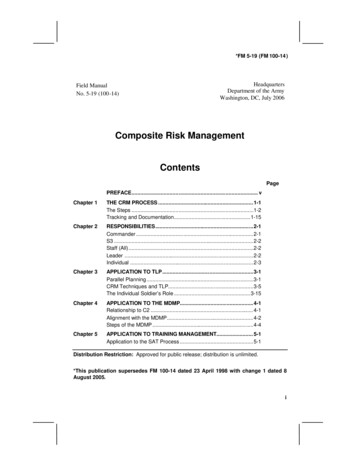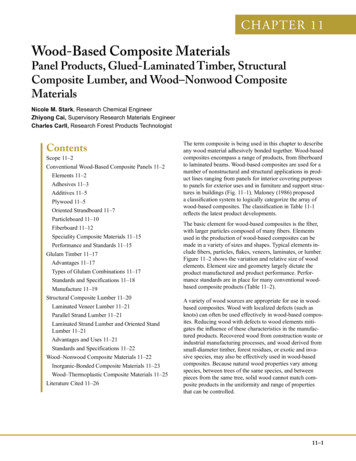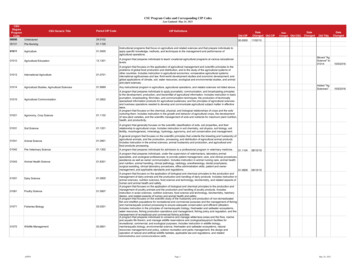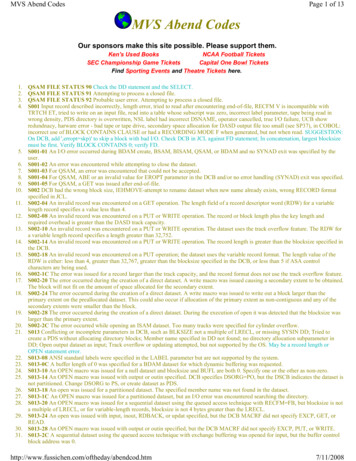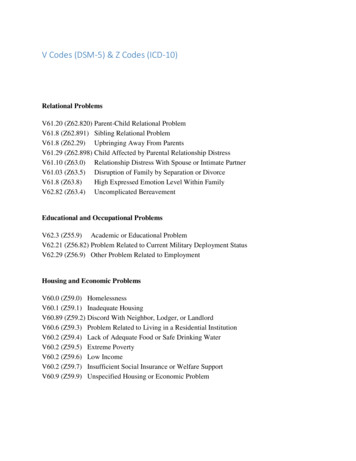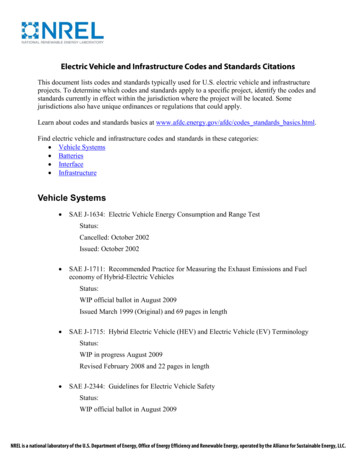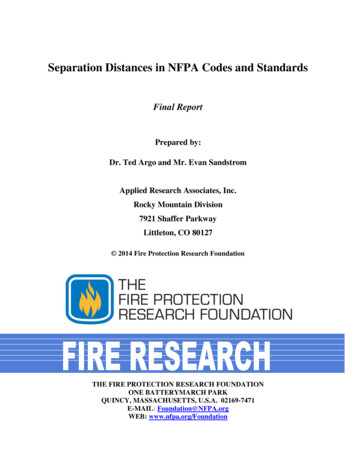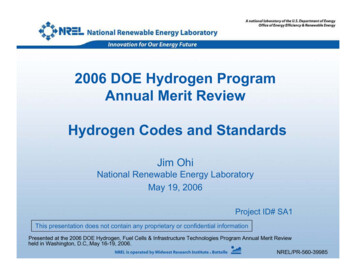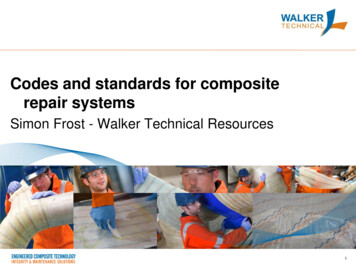
Transcription
Codes and standards for compositerepair systemsSimon Frost - Walker Technical Resources1
Relevant standards for composite repairsThe relevant, applicable standards for composite repairsystems are; ISO/TS 24817 – Composite repairs for piping. ASME PCC-2 Articles 4.1 and 4.2 High and low risk Non-metallic composite repair systems for pipelines andpipeworkIn essence there is no significant or major differencebetween these two standards. Developments in onestandard are mirrored in the other standard.
Scope of the applicable standardsThe scope of ISO/TS 24817 and ASME PCC-2 covers thefollowing components; Pipelines Pipework including straights, elbows, tees, flanges,reducers, valve bodies Tanks and vessels including nozzles and attachmentsThe standard can also act as guidance for repairs appliedto risers and structural strengthening applications
Acceptable defect typesISO/TS 24817 nor ASME PCC-2 do not define what is anacceptable defect to repair, but assumes that a decision hasbeen made to repair a given defect, under the relevant code,e.g. B31G, API 579, ASME FFS-1 using a composite repair.The decision of what constitutes an acceptable defect forrepair is beyond the remit of both ISO/TS 24817 and ASMEPCC-2.
Where can they be used?5
Contents of the standardsThe contents of ISO/TS 24817 and ASME PCC-2 includesdetails on; Qualification; tests repair suppliers are required toperform to conform to the standard Design; how to determine the repair thickness andextent Installation; guidance is provided on the critical issuese.g. surface preparation, minimum QA/QCrequirements and applicator training Inspection; guidance on how to inspect the repairsystem
Defect typesThe two generic types of defects that are covered by ISO/TS24817 and ASME PCC-2 are; Defect Type A Caused by external corrosion or mechanical damage Not through wall Application of the repair will arrest further degradation Defect type B Caused by Internal corrosion or erosion Through wall (or will become through wall during the lifetime ofthe repair) Degradation of the defect will continue after the repair is applied
Defect typesCrack like defects are not specifically covered by ISO/TS 24817 orASME PCC-2, however; If it can be demonstrated in a defect assessment procedurethat the crack will not grow then a composite repair can beapplied to strengthen the affected region. Composite repairs may be applied to surface breakingcracks where the intention is to prevent leakage.In general the repair of crack like defects using composite repairswill not prevent further crack growth.
Philosophy The overall philosophy of the two standards is“performance based” In other words no prescription in terms of materials (fibresor resin) nor minimum strengths is provided The repair supplier demonstrates the performance of thecomposite repair system through testing – both standardsspecify what testing should be performed The testing performed should replicate those proceduresused in the field9
Composite repair types There is no restriction on the material types nor the configuration offibres and resin Most composite repair systems use one of the followingcombination of material types; Fibres – Aramid, Carbon, Glass Resins – Epoxy, Polyurethane Construction of the repair system; Wet lay-up Pre-manufactured bands or coils All combinations of the above are considered within either standard10
Repair lifetime The standards do not use the terminology “temporary” or“permanent” – terms are vague The required lifetime of the repair is defined by the end user (onwhich the design of the repair is based) The maximum lifetime considered within either standard is 20years The repair is designed for the defined lifetime implying that at theend of life the end user must either replace the repaired line orassess the status of the repair and extend its lifetime11
How to design repairs?Design of a composite repair answers the following questions; Is the repair strong enough in all loading directions? (strengthcalculation) Allowance for the remaining wall thickness of steel Composite repair withstands the full applied load Will the repair remain bonded to the surface ? (adhesionstrength calculations) Is the extent of repair sufficient to ensure load transfer betweenrepair and substrate?Output of design is the repair thickness and extent of repair12
Design considerations Base unit for design is the combined structure – Repair, surfacepreparation procedure and substrate For internal defects and through wall defects, the application of acomposite repair will not stop internal corrosion. Therefore need toassume that internal defect will grow through wall during designlife For external defects, the application of a composite repair willprevent further corrosion Qualification test data is used as input for the repair design13
Effect of material and surface preparationDesign pressure against repair thickness for a design lifetime of 20years and a circular through wall defect of diameter 25 mm.807060Glass/Epoxy - Sa 2.5Pressure (bar)50Glass/Epoxy - ST340Glass/Epoxy - ST2Glass/Polyurethane - Sa 2.530Glass/Polyurethane - ST320Glass/Polyurethane - ST2100010203040Repair thickness (mm)14
How to install repairs?Most critical step in the use of composite repairs Get the surface preparation and other installationissues correct, if not, no matter how well designedthe repair it will leak or fail!! Repairs should always be applied by trained,competent applicators QA controls should always be followed as defined ininstallation method statement Measurement of surface roughness Repair laminate lay-up Measurement of cure – Barcol hardness15
Summary of inspection recommendations For external defects Visual inspection of repair – delamination will be initiated at the edge ofrepair For internal defects Visual inspection for edge delamination and also check for discolouration Radiography or Electromagnetic (with a stand-off) e.g. SLOFEC, PEC, forinspection of the steel substrate underneath the repair Unable as yet to inspect reliably the interface (development trials on-going) Current activities PRCI initiative – Inspection of composite repairs (ESR Technology, UK)16
UK HSE Perspective Both non safety critical and safety critical structures can be repaired in line witha risk assessment Specific guidance can be found in HSE OSN - ‘Weldless repair of safety criticalpiping systems’. The philosophy for repair is;1.Replace like for like2.Temporary repair until replacement3.Permanent repair only where replacement is not practical Each repair should be designed on a bespoke basis and have a defined life The HSE do not approve as such repairs but require the management of theintegrity to be demonstrated17
Repair Class – Temporary or Permanent?External corrosion – for all Classes of repair – “Permanent”PressureInternal corrosionClass 3e.g. Hydrocarbon lines“Temporary”Class 2e.g. Fire water linesEither “Temporary” or “Permanent”Class 1e.g. Drain lines“Permanent”Consequence18
Conclusions Two standards, ISO/TS 24817 and ASME PCC-2 are available toensure the composite repairs are an engineering solution The scope of these standards covers pipelines, piping systems,tanks and vessels The lifetime of a composite repair can be up to 20 years. Thelifetime is defined by the end user. The standards are not defect assessment standards, the startingpoint is that a decision has been taken to use a composite repair The standards provide detailed design procedures and guidanceon installation, training of applicators and in-service inspection19
Reactive repairsOverview Immediate integrity issue possiblyresulting in loss of production Client requires an engineered, costeffective solution that minimises impacton productionWhy a composite solution ? Cost effective Minimal lead time – materials andapplicators available at short notice Integrity maintained through anengineered repair solution with adefined lifetime20
Planned projects – Black drainsOverview Four platform project to reinstate life of field integrity toblack drain systems Up to 150 meters of composite repair per platform TechnowrapTM composite repair solution determined byClient to be most cost effective solutionWhy a composite solution ? 40% saving over other options Overboard application through rope access Core crew FM team trained to assist – significantly lesspressure on bed space Applied live – no downtime, zero impact on production Integrity maintained through an engineered repair solutionwith a life of field guarantee21
Planned projects – Pipeline repairOverview Oil transport pipeline suffering 6 o’clock internalcorrosion Client required production to be maintained TechnowrapTM composite repair solution determinedby Client to be most cost effective solutionWhy a composite solution ? Applied live – no downtime and therefore zero impacton production Integrity maintained through an engineered repairsolution with a life of field guarantee22
Caisson and riser repairsOverview Reinstatement of integrity for eitherinternal or external corrosion Need to design repair for bothinternal pressure and axial loadsWhy a composite solution ? Applied live – no downtime andtherefore zero impact on production Can be applied through ropeaccess Integrity maintained through anengineered repair solution with alife of field guarantee Internal / external corrosion Pressure/Temp: 2 Bar / 15 C 36” sea-water caisson External corrosion Pressure/Temp: 25 Bar / 35 C 36” hydrocarbon riser External corrosion Pressure/Temp: 11 Bar / 38 C 12” closed drain23
ASME PCC-2 Articles 4.1 and 4.2 High and low risk - Non-metallic composite repair systems for pipelines and pipework In essence there is no significant or major difference between these two standards. Developments in one standard are mirrored in the other standard. Scope of the applicable standards . The scope of ISO/TS 24817 and ASME PCC-2 covers the following components; File Size: 781KBPage Count: 23
